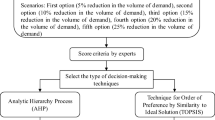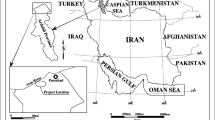Abstract
Many regions has been facing formidable freshwater management and planning challenges. Concerns about limited water allocations, conservation of environmental and water qualities and policies for sustainable water use have been increased because rising water demand would cause water shortage in the near future. Therefore, it is necessary to look into possible alternative water resources management plans to mitigate the potential water shortage. However, it is not straightforward to predict and analyze the various situations likely to be occurred in the future. Also, finding an optimal solution among many alternatives to mitigate the water shortage is a complex task. In this study, a methodology of predicting and analyzing the water resources situations in the future using the K-WEAP (Korea Water Evaluation and Planning system) is presented and an optimal alternative is determined using the MCDA (Multi-Criteria Decision Analysis) that takes into account the economic, environmental, and social sectors. The proposed methodology is applied to the Nakdong River basin in South Korea to calculate water budget and possible water shortage. An optimal water shortage mitigation policy for the study basin is also suggested to help decision maker develop long-term water resources management strategies.
Similar content being viewed by others
References
Ahmoud, M. R., Fahmy, H., and Labadie, J. W. (2002). “Multicriteria siting and sizing of desalination facilities with geographic information system.” Journal of Water Resources Planning and Management, Vol. 128, No. 2, pp. 113–120.
Belton, V. and Stewart, T. J. (2002). Multiple criteria decision analysis. An intergrated approach, Kluwer Academic Publishers, Norwell, Messachusetts.
Choi, D. J. and Park, H. K. (2000). “Analysis of water privatization scenarios with mulit-criteria decision techniques.” Journal of Korean Society of Civil Engineers, Vol. 20, No. 1, pp. 175–187.
Duckstein, L., Treichel, W., and El Magnouni, S. (1994). “Ranking ground-water management alternatives by multicriterion analysis.” Journal of Water Resources Planning and Management, Vol. 120, No. 4, pp. 546–565.
Flug, M, Seitz, H. L. H., and Scott, J. F. (2000). “Multicriteria decision analysis applied to Glen Canyon Dam.” Journal of Water Resources Planning and Management, Vol. 126, No. 5, pp. 270–276.
Goicoechea, A., Stakhiv, E. Z., and Li, F. (1992). “Experimental evaluation of multiple criteria decision models for application to water resources planning.” Water Resources Bulletin, Vol. 28, No. 1, pp. 89–102.
Joubert, A. and Pollard, S. (2000). “Using multi-criteria decision analysis in catchment management: A case study of the Sand River, Mpumulanga, South Africa.” African Journal of Aquatic Science, Vol. 25, No. 1, pp. 238–242.
Joubert, A., Stewart, T. J., and Eberhard, R. (2003). “Evaluation of water supply augmentation and water demand management options for the City of Cape Town.” Journal of multi-criteria decision analysis, Vol. 12, No. 1, pp. 17–25.
KMOCT (2006). National water resources plan (2006–2020), Korean Ministry of Construction and Transportation.
KMOST (2007). Building of value evaluation system of water resources and water related technology, Korean Ministry of Science and Technology.
Lee, H. J. and Shim, M. P. (2002). “Decision making for priority of water allocation during drought by analytic hierarchy process.” Journal of Korea Water Resources Association, Vol. 35, No. 6, pp. 703–714.
OECD (2005). Handbook on constructing composite indicators: Methodology and user guide, Organization for Economic Cooperation and Development Statistics Working Paper.
Park, T. S. (2002). “The evaluation perspective of stream weight in AHP.” Journal of Korea Water Resources Association, Vol. 35, No. 6, pp. 685–692.
Raskin, P., Hansen, E., Zhu, Z., and Stavisky, D. (1992). “Simulation of water supply and demand in the aral sea region.” Water International, Vol. 17, No. 2, pp. 55–67.
Ridgley, M. A. (1993). “A multicriteria approach to allocation water during drought.” Resources and Optimization, Vol. 9, No. 2, pp. 135–149.
Roy, B., Slowinski, R., and Treichel, W. (1992). “Multicriteria programming of water supply systems for rural areas.” Water Resources Bulletin, Vol. 28, No. 1, pp. 13–31.
Stockholm Environment Institute-Boston Center. (2001). K-WEAP User guide, SEI-US.
Tecle, A., Fogel, M., and Duckstein, L. (1988). “Multicriterion selection of wastewater management alternatives.” Journal of Water Resources Planning and Management, Vol. 114, No. 14, pp. 383–398.
Thiessen, E. M. and Loucks, D. P. (1992). “Computer assisted negotiation of multiobjective water resources conflicts.” Water Resources Bulletin, Vol. 28, No. 1, pp. 163–177.
Yasin, A. -Z., Muhammad, S., Kdeb, A. -J., and Atef, A. -K. (2002). “Application of decision support system for sustainable management of water resources in Azaq Basin-Jordan.” Water International, Vol. 27, No. 4, pp. 532–541.
Author information
Authors and Affiliations
Corresponding author
Rights and permissions
About this article
Cite this article
Choi, SJ., Kim, J.H. & Lee, DR. Decision of the water shortage mitigation policy using Multi-Criteria Decision Analysis. KSCE J Civ Eng 16, 247–253 (2012). https://doi.org/10.1007/s12205-012-0008-z
Received:
Accepted:
Published:
Issue Date:
DOI: https://doi.org/10.1007/s12205-012-0008-z




